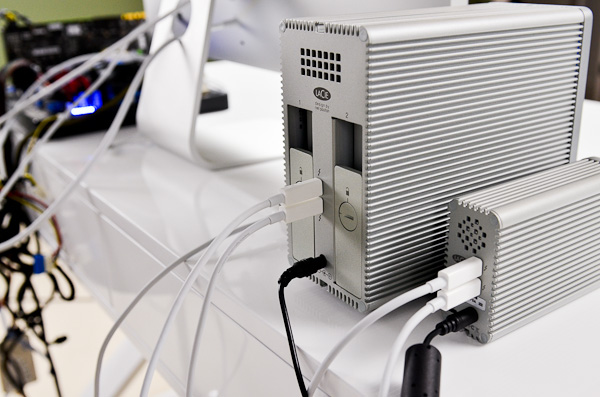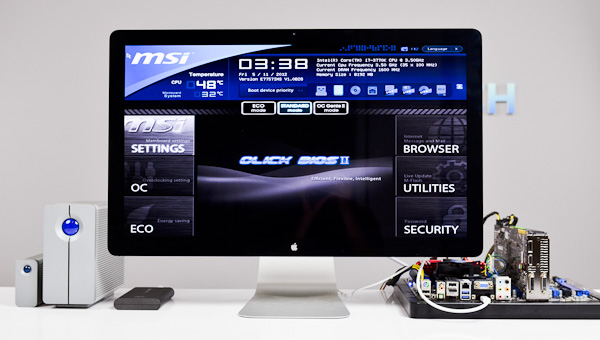A First Look at Thunderbolt on Windows with MSI's Z77A-GD80
by Anand Lal Shimpi on May 11, 2012 1:32 PM EST- Posted in
- Motherboards
- CPUs
- Intel
- MSI
- Thunderbolt
The Storage Devices & Performance
Other than Apple's Thunderbolt Display, every other TB device we've tested has been some sort of storage device. In my lab I've got Promise's Pegasus R6, LaCie's 2big and Little Big Disk (SSD), Seagate's GoFlex Thunderbolt adapter and Elgato's Thunderbolt SSD. With the exception of the Pegasus R6, which currently lacks Windows drivers, all of the storage devices I tested worked with MSI's Z77A-GD80 under Windows. Although there are workarounds for getting the Pegasus up and running under Windows, I encountered a number of hangs and general system unhappiness whenever I tried them on this platform. I suspect this has something to do with why Promise has yet to officially release Windows drivers for the Pegasus.
The rest of the storage devices, as you would expect, just worked. I didn't need to install any drivers as all of their internal controllers had native support under Windows 7. Again, I couldn't hot plug any of these devices once Windows was running - all of them had to be present at boot.
Just as I've seen under OS X, with complex Thunderbolt chains you'll sometimes have a device that hangs in the chain and prevents some or all TB devices from working. I did encounter this behavior more frequently under Windows than I did under OS X. Keep in mind that every single Thunderbolt device on the market today was pretty much developed and tested against Macs, it's going to be a little while before we get perfect behavior under Windows. We don't even have perfect behavior under OS X yet either. My hope is that as more platforms ship with Thunderbolt support, and as we get more Thunderbolt devices, compatibility and behavior validation will both improve. I've also heard that the early Thunderbolt controllers were more finicky than Cactus Ridge, so it's possible that newer TB devices that come out this year will just inherently be better behaved. This is purely hearsay however, I don't have any hard evidence to back it up.
Update: Intel tells us that an updated Pegasus driver is in the works that will address the issues we've seen. Other finicky behavior is also expected to be addressed through the Thunderbolt on Windows certification process.
Since I couldn't get the Pegasus working, I had to resort to combining a bunch of my other Thunderbolt storage devices to measure performance. I created a chain combining LaCie's 2big, the SSD Little Big Disk and Elgato's Thunderbolt SSD along with Apple's Thunderbolt Display. I ran a 128KB sequential read test at a queue depth of 32 across all of the drives, while pushing the Thunderbolt Display at its native 2560 x 1440 resolution:
The best I ever got under OS X was 8Gbps using four SandForce SSDs in the Promise Pegasus. At 7Gbps using a far less elegant setup, this isn't bad at all. Keep in mind that while we're reading at 7Gbps, the GD80 was also using around 7Gbps of bandwidth to drive the Thunderbolt Display at 2560 x 1440. Total available bandwidth for a single-port Thunderbolt device is 20Gbps bi-directional (40Gbps total), so there's still additional headroom available.
Moving Forward
MSI's Z77A-GD80 finally brings Thunderbolt to Windows desktops. With a few exceptions, the experience is quite similar to OS X. The major differences are that some devices clearly need more compatibility testing with these new platforms, and that you can't hot plug Thunderbolt devices under Windows. The former is solvable given additional time, while the latter can be more annoying in the long run if a workaround isn't found. For a single, high-speed storage device under Windows, USB 3.0 is going to be the simplest route. It's only when you want to start pushing even more bandwidth and/or add a display into the mix that Thunderbolt becomes your only solution.
Thunderbolt's functionality otherwise looks very similar under Windows as it does under OS X. The interface doesn't require any specific drivers and in the best conditions it just works. Thunderbolt's behavior remains quite finicky however, even more so under Windows. You'll want to wait for either the next generation of Thunderbolt devices or for the current device vendors to get some more time validating their Thunderbolt products on Windows platforms. Given that the first Thunderbolt equipped PC motherboards haven't even shipped yet, you've got some time.
Update: Intel has informed us that we will see updated drivers for Windows certified Thunderbolt devices that will enable hot plugging under Windows. Intel further informed us that MSI's board has not yet made it through the certification process and a lot of these teething issues will hopefully be addressed by then.
For much of the past year I've been calling for cheaper Thunderbolt storage devices, but with the arrival of Thunderbolt on Windows I'll modify my plea: we need more Thunderbolt display devices as well. As the desktop PC evolves, it would be nice to have only a single cable running from your PC to a Thunderbolt equipped display that acts as the IO hub for all of your peripherals. I'm thinking of something like Apple's Thunderbolt Display, but even heavier on the expansion side and with OS-independent display controls.













98 Comments
View All Comments
repoman27 - Saturday, May 12, 2012 - link
Overprovisioning is usually not a problem. What you have here is oversubscription, which definitely can be. The only chips on this motherboard that seem to be using the 8 PCIe lanes off of the PCH are the FireWire and SATA controllers, which use one apiece, and the Thunderbolt controller, which seems to be a 4 channel Cactus Ridge chip which uses four lanes. The audio chip does not connect to the PCH via PCIe, nor does the PHY chip for the Intel NIC, as far as I know. If they had just gone with 2 less PCIe x1 slots, they wouldn't have had any contention issues.It's odd that MSI would use a 4 channel Thunderbolt controller and only provide a single Thunderbolt port. The PCIe throughput figures definitely point to this being the 4 channel version though. If it can drive 2 Thunderbolt displays, then it definitely is, and I'm guessing that the reason why only two of the display outputs work at the same time is because 2 of the 3 video signals from the IGP are going to the Thunderbolt controller.
Death666Angel - Monday, May 14, 2012 - link
But then VGA+HDMI would not work, would it?repoman27 - Monday, May 14, 2012 - link
Nope. I realized that after I posted, but then I hurt my brain trying to figure out how the display signals were actually routed from the PCH in order to cause this behavior.Jamiex - Sunday, May 13, 2012 - link
could you get as high framerate when playing game through thunderbolt with the Lucid's Virtu GPU virtualization and an external GPU as you would when connecting directly to the external GPU? I don't fully understand how it works.Death666Angel - Monday, May 14, 2012 - link
Pretty much, you lose a few percentage points going through the iGPU frame buffer. The way it works is that the GTX680 (or any dGPU) renders the frame and has it in its frame buffer. The Virtu software then copies said frame buffer over to the iGPU frame buffer and that iGPU has a direct connection to TB/HDMI/VGA off the mainboard. The act of copying the frame buffers has some overhead, but performance in the last review I saw of it was 97% to 100%.gtm - Monday, May 14, 2012 - link
I find Thunderbolt interesting for the ability to put one big and loud pc in one room, and get all I/O in another room, saving noise, space and cable mess.But is it possible to wake an hibernating PC using for example an USB-Keyboard connected to a thunderbolt display?
Death666Angel - Monday, May 14, 2012 - link
3m cable length for the copper version doesn't seem like enough for that usage case though. :-)repoman27 - Monday, May 14, 2012 - link
That's why you need to get one of these:http://www.macworld.com/article/1166542/optical_ca...
gtm - Tuesday, May 15, 2012 - link
Yes, I was thinking of those. Maybe even with a little more bandwidth, so that a Quad-HD display can be plugged, when they become affordable.But running upstairs to resume from suspend is no fun.
roaminggnome - Tuesday, May 15, 2012 - link
Did you happen to test to see if the Display supported Audio IN/Out or Video over the built in speakers/iSight?